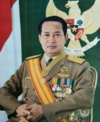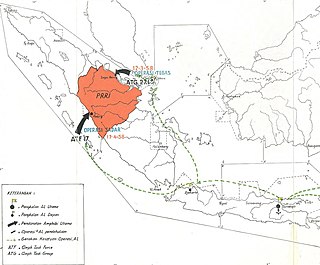
The Revolutionary Government of the Republic of Indonesia was a revolutionary government set up in Sumatra to oppose the central government of Indonesia in 1958.

The Emergency Government of the Republic of Indonesia was established by Indonesian Republicans after the Netherlands occupied the at the time capital city of Yogyakarta in Central Java, the location of the temporary Republican capital during the Indonesian National Revolution. It was established in the city of Bukittinggi and led by Sjafruddin Prawiranegara.

The president of the Republic of Indonesia is both the head of state and the head of government of the Republic of Indonesia. The president leads the executive branch of the Indonesian government and is the commander-in-chief of the Indonesian National Armed Forces. Since 2004, the president and vice president are directly elected to a five-year term, once renewable, allowing for a maximum of 10 years in office.
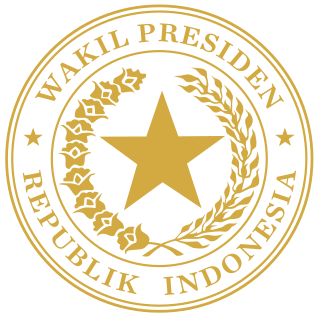
The vice president of the Republic of Indonesia is second-highest officer in the executive branch of the Indonesian government, after the president, and ranks first in the presidential line of succession. Since 2004, the president and vice president are directly elected to a five-year term.

Assaat Datuk Mudo, known as Mr. Assaat, was born in Banuhampu, Agam, West Sumatra, Dutch East Indies. He was the only President of the Yogyakarta-based Republic of Indonesia before it became the part of the United States of Indonesia, and was in office from December 1949 until August 1950. He and a number of Indonesia founders, fought for the independence of Indonesia from the Dutch.
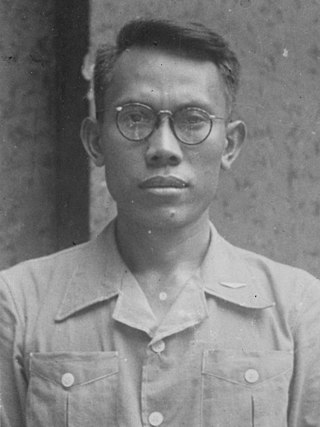
Sjafruddin Prawiranegara was an Indonesian statesman and economist. He served as the head of government in the Emergency Government of the Republic of Indonesia, as Minister of Finance in several cabinets, and was the first Governor of Bank Indonesia between 1951 and 1958. He then became the prime minister of the Revolutionary Government of the Republic of Indonesia, a shadow government set up in opposition to the country's central government.

The First Hatta Cabinet, also known as the Presidential Cabinet, was Indonesia's seventh cabinet. It was formed by Vice President Mohammad Hatta, who was instructed to do so by President Sukarno on 23 January 1948, the same day the previous cabinet was declared dissolved. Following the second Dutch military aggression, when the republican capital of Yogyakarta was seized and most of the cabinet arrested, much of the cabinet was captured and sent into exile, although it was not formally disbanded. After the political leadership returned effective 13 July 1949 the cabinet continued its mandate until it was reshuffled on 4 August.

Sjafruddin Prawiranegara's Emergency Cabinet was the government of the Emergency Government of the Republic of Indonesia (PDRI), effectively Indonesia's government-in-exile, established in Bukittinggi, West Sumatra following the second Dutch military aggression when the republican capital of Yogyakarta was seized and most of the cabinet allowed itself to be captured in the hope of attracting sympathy from the outside world.

The Natsir Cabinet was the first cabinet formed after the dissolution of the United Republic of Indonesia and returned to the Unitary State of the Republic of Indonesia. This cabinet was in charge from 6 September 1950 – 20 March 1951.

Teuku Mohammad Hasan was an Indonesian politician and national hero from Aceh, who served as the first and only governor of Sumatra from 1945 until 1948. He also served as a cabinet minister in Sjafruddin Prawiranegara's emergency cabinet and was a member of both the Senate of the United States of Indonesia (USI) and the Provisional People's Representative Council (DPRS) of the Republic of Indonesia.
National Hero of Indonesia is the highest-level title awarded in Indonesia. It is posthumously given by the Government of Indonesia for actions which are deemed to be heroic, defined as "actual deeds which can be remembered and exemplified for all time by other citizens" or "extraordinary service furthering the interests of the state and people". The Ministry of Social Affairs gives seven criteria which an individual must fulfill, as follows:
- Have been an Indonesian citizen who is deceased and, during his lifetime, led an armed struggle or produced a concept or product useful to the state;
- Have continued the struggle throughout his life and performed above and beyond the call of duty;
- Have had a wide-reaching impact through his actions;
- Have shown a high degree of nationalism;
- Have been of good moral standing and respectable character;
- Never surrendered to his enemies; and
- Never committed an act which taints his or her legacy.

Alexander Andries Maramis, more commonly known simply as A. A. Maramis, was an Indonesian politician and National Hero of Indonesia, who was involved in the struggle for independence. He was a member of the Investigating Committee for Preparatory Work for Independence (BPUPK), the organization which drafted the Constitution of Indonesia. In the early stages of the Indonesian government, following the Proclamation of Independence, he served as both Minister of Finance and Minister of Foreign Affairs. After the end of the Indonesian National Revolution, he served as the Indonesian ambassador to several nations, including the Philippines, West Germany, and the Soviet Union.

The Commander of the Indonesian National Armed Forces is the professional head and highest-ranking officer of the Indonesian National Armed Forces. Directly answerable to the president of Indonesia, the position is held by any four-star officer who previously served as Chief of Staff of the Indonesian Army (KSAD), Chief of Staff of the Indonesian Navy (KSAL) or Chief of Staff of the Indonesian Air Force (KSAU).

The Indonesian Muslims' Party, better known by the syllabic abbreviation Parmusi, was an Islamic political party in Indonesia which existed from 1968 until 1973. Founded as the legal successor to the Masyumi Party, it came fourth in the 1971 Indonesian legislative election, winning 5.36% of the vote and 24 seats in the People's Representative Council. In 1973, Parmusi was merged into the United Development Party.

Brig. Gen. Daan Jahja or Daan Yahya was an Indonesian military officer who was the Chief of Staff of the Siliwangi Division in 1948 and the Military Governor of Jakarta from 1949 to 1950.
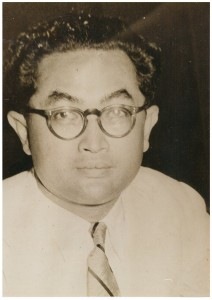
Lukman Hakim was an Indonesian politician who served as Minister of Finance between 1948 and 1950, serving under both the Emergency Government of the Republic of Indonesia and the Republic of Indonesia during the United States of Indonesia period. He was also the Governor of Bank Indonesia between 1958–1959, and the Ambassador to West Germany between 1961 until his death in 1966.

Ir. Raden Mas Panji Surachman Tjokroadisurjo, more commonly referred to Surachman Tjokroadisurjo, was an Indonesian politician and academic from the province of Central Java. He served in a number of national cabinets during the National Revolution, as the Minister of Welfare and later the Minister of Finance. Born in Wonosobo, Dutch East Indies, he studied chemical engineering at the Delft Institute of Technology, Netherlands. He returned to Indonesia in 1920, and worked for the Dutch government in a chemical laboratory in Bandung.


